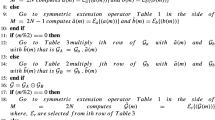Abstract
In this paper, we propose efficient modular polynomial multiplication methods with applications in lattice-based cryptography. We provide a sparse polynomial multiplication to be used in the quotient ring \(({\mathbb {Z}}/ p{\mathbb {Z}}) [x] / (x^{n}+1)\). Then, we modify this algorithm with sliding window method for sparse polynomial multiplication. Moreover, the proposed methods are independent of the choice of reduction polynomial. We also implement the proposed algorithms on the Core i5-3210M CPU platform and compare them with number theoretic transform multiplication. According to the experimental results, we speed up the multiplication operation in \(({\mathbb {Z}}/ p{\mathbb {Z}}) [x] / (x^{n}+1)\) at least \(80~\%\) and improve the performance of the signature generation and verification process of GLP scheme significantly.
Similar content being viewed by others
References
Akleylek S, Yüce Tok Z (2014) Efficient arithmetic for lattice-based cryptography on GPU using the CUDA platform. In: Proceedings of IEEE 22nd signal processing and communications applications conference (SIU 2014), pp 854–857
Akleylek S, Yüce Tok Z (2014) Efficient interleaved montgomery modular multiplication for lattice-based cryptography. IEICE Electron Exp 11(22):1–6
Aysu A, Patterson C, Schaumont P (2013) Low-cost and area efficient FPGA implementations of lattice-based cryptography. In: IEEE HOST, pp 81–86
Bailey DV, Coffin D, Elbirt A, Silverman JH, Woodbury AD (2001) NTRU in constrained devices. In: CHES 2001. LNCS, vol 2162, pp 262–272
Chen DD, Mentens N, Vercauteren F, Roy SS, Cheung RCC, Pao D, Verbauwhede I (2014) High-speed polynomial multiplication architecture for ring-LWE and SHE cryptosystems. IEEE Trans Circuits Syst I Regul Pap. doi:10.1109/TCSI.2014.2350431
Ducas L, Durmus A, Lepoint T, Lyubashevsky V (2013) Lattice signatures and bimodal Gaussians. In: CRYPTO 2013. LNCS, vol 8042, pp 40–56
Güneysu T, Lyubashevsky V, Pöppelmann T (2012) Practical lattice-based cryptography: a signature scheme for embedded systems. In: CHES 2012. LNCS, vol 7428, pp 530–547
Güneysu T, Lyubashevsky V, Pöppelmann T (2014) Lattice-based signatures: optimization and implementation on reconfigurable hardware. IEEE Trans Comput. doi:10.1109/TC.2014.2346177
Güneysu T, Oder T, Pöppelmann T, Schwabe P (2013) Speed records for lattice-based signatures. In: PqCrypto 2013. LNCS, vol 7932, pp 67–82
Hoffstein J, Silverman JH (1998) NTRU: a ring-based public key Cryptosystem. In: ANTS-III. LNCS, vol 1423, pp 267–288
Karatsuba A, Ofman Y (1962) Multiplication of many-digital numbers by automatic computers. Proc USSR Acad Sci 145:293–294
Knuth D (1997) The art of computer programming volume 2: seminumerical algorithms. Addison-Wesley, Boston
Lee MK, Kim JW, Song JE, Park K (2007) Sliding Window Method for NTRU. In: ANCS 2007. LNCS, vol 4521, pp 432–442
Lee MK, Kim JW, Song JE, Park K (2013) Efficient implementation of NTRU cryptosystem using sliding window methods. IEICE Trans Fundam E96–A(1):206–214
Lindner R, Buchmann J, Doering M (2008) Efficiency improvements for NTRU. In: Sicherheit 2008. LNI, vol 128, pp 163–178
Lyubashevsky V, Peikert C, Regev O (2010) On ideal lattices and learning with errors over rings. In: EUROCRYPT 2010. LNCS, vol 6110, pp 1–23
Peikert C (2014) Lattice cryptography for the internet. In: PQCrypto 2014. LNCS, vol 8772, pp 197–219
Pollard JM (1971) The fast Fourier transform in a finite field. Math Comput 25(114):365–374
Pöppelmann T, Güneysu T (2012) Towards efficient arithmetic for lattice-based cryptography on reconfigurable hardware. In: LATINCRYPT 2012. LNCS, vol 7533, pp 139–158
Roy SS, Vercauteren F, Mertens N, Chen DD, Verbauwhede I (2014) Compact ring-LWE cryptoprocessor. In: CHES 2014. LNCS, vol 8731, pp 371–391
Scwabe P (2015) https://cryptojedi.org/crypto/index.shtml#lattisigns. Accessed 23 April 2015
Shor PW (1997) Polynomial-time algorithms for prime factorization and discrete logarithms on a quantum computer. SIAM J Comput 26(5):1484–1509
Acknowledgments
Sedat Akleylek is partially supported by TÜBITAK under 2219-Postdoctoral Research Program Grant. Erdem Alkım is partially supported by TÜBITAK under 2214-A Doctoral Research Program Grant.
Author information
Authors and Affiliations
Corresponding author
Ethics declarations
Conflict of interest
The authors declare that they have no conflict of interest.
Rights and permissions
About this article
Cite this article
Akleylek, S., Alkım, E. & Tok, Z.Y. Sparse polynomial multiplication for lattice-based cryptography with small complexity. J Supercomput 72, 438–450 (2016). https://doi.org/10.1007/s11227-015-1570-1
Published:
Issue Date:
DOI: https://doi.org/10.1007/s11227-015-1570-1




